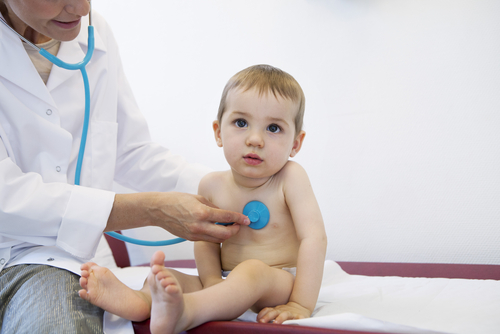Breathing Difficulties Linked to Ribcage Muscle Problems in Children with SMA
Written by |

A poor contribution by the ribcage to breathing is a characteristic feature of children with spinal muscular atrophy (SMA) type 1 and 2, and is apparent from infancy.
The study, “Spontaneous Breathing Pattern as Respiratory Functional Outcome in Children with Spinal Muscular Atrophy (SMA),” published in the journal PLOS ONE, showed that the severity of motor symptoms is directly proportional to breathing difficulties, and concluded that a suggested treatment for SMA children, salbutamol, did not improve ventilation.
Researchers also showed that the type and severity of breathing difficulties can be assessed in all SMA children by analyzing ventilatory and muscle involvement patterns.
Breathing problems are the main causes of hospitalization and death in SMA, and work on new treatments aims to improve breathing and prevent respiratory complications. But more efforts are needed, as are better measures to evaluated the effects of interventions in children and infants.
Two muscle groups, particularly, allow people to breath: the diaphragm and the muscles of the ribcage. In SMA, the diaphragm is preserved, so studies have focused on ribcage muscles during quiet breathing.
Earlier studies have indicated that these muscles do not work properly in children with SMA1 and SMA2, but they were done in patients in a flat, or lying, position. In this position, the diaphragm contributes more to inhalation than the ribcage. Researchers at the Polytechnic University of Milan and the Carlo Besta Neurological Research Institute Foundation in Italy decided to also study children in seated positions.
The research team assessed ventilatory and muscle involvement patterns in 32 SMA1, 51 SMA2, eight SMA3 children younger than eight years of age, and 20 healthy controls.
They discovered that children with SMA1 were only adequately ventilated when lying down and breathing rapidly with shallow breaths, and that the ribcage moved in an abnormal way during breathing.
SMA2 children managed to maintain normal ventilation in seated position. This was achieved with more rapid breathing, and again showed a poor contribution from the ribcage.
Salbutamol (marketed as Ventolin, among other brand names) has been proposed to aid motor function and spirometry in SMA, and is currently suggested as standard supportive treatment for SMA children at many treatment centers. The research team, however, did not find this treatment improved ventilation and ribcage muscle patterns in the children.
Researchers also found that the severity of motor symptoms was directly correlated to the ventilation and patterns of muscle use.






